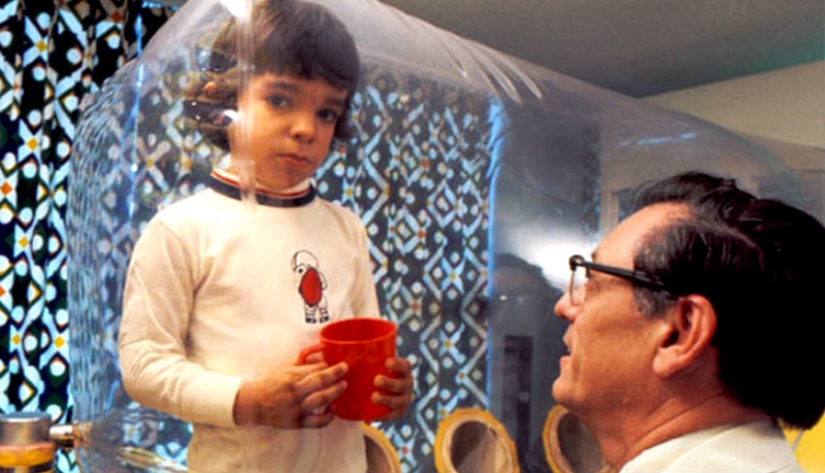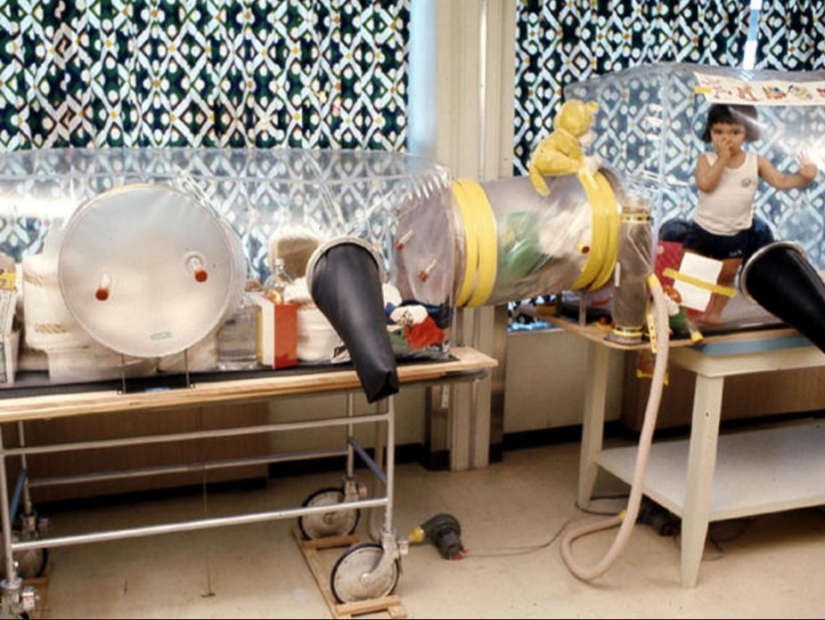The boy in the bubble: a dozen years waiting for death
Categories: Children | Health and Medicine | History
By Pictolic https://pictolic.com/article/the-boy-in-the-bubble-a-dozen-years-waiting-for-death.htmlThis case is very important in the history of medicine — and not only because of the sad fate of the boy David Phillip Vetter, but also because of the huge chain of ethical problems that it poses and to which there is still no definite answer.


Let's remember Tolstoy and his passage about unhappy families. The Vetter family, devout Christians, were unhappy because of genetic problems. Their eldest son, David Joseph Vetter III, died at the age of seven months. The diagnosis is terrible and gives almost no chance: SCID, aka alimphocytosis, aka Glanzman—Rinicker syndrome, aka severe combined immunodeficiency (TKID), aka thymic alimphoplasia. After the described case, the disease will receive another name.

The essence of the disease is as follows: a genetic defect disrupts the thymus gland, as a result of which the born child has no (or almost no) T-lymphocytes, and B-lymphocytes exist, but do not work. Usually this disease occurs with a probability of 1:100,000 newborns (except Navajo and Apache Indians, there is a frequency of 1:2500). However, if a boy is born with this disease, the probability that the next boy will be the same is 50%.

The only chance to save a newborn's life is a bone marrow transplant. The Vetter family had a potential donor — their daughter Catherine. Apparently, that's why they decided to give birth to an heir after all. Moreover, doctors from Baylor Medical College — John Montgomery, Mary Ann Stout and Raphael Wilson — assured the parents that if the same thing happens, it will be possible to put the boy in a sterile box before bone marrow transplantation. For some reason, no one thought about what would happen if the bone marrow did not fit.

The baby was born, the bone marrow did not fit. The boy was left to live in a sterile bubble. He was baptized with sanitized holy water and remained imprisoned for a dozen years, almost until his death.
Before getting into David's sterile cocoon, water, air, food, diapers and clothes were thoroughly disinfected. David himself was touched exclusively with the help of special plastic gloves embedded in the wall of the bubble. Toys, books and other objects were cleaned of the slightest remnants of glue and labels, then placed in a chamber filled with ethylene oxide and kept there for four hours at a temperature of 60 ° C, after which they were aerated for 1-7 days.

The boy became psychologically unstable, irritable and depressed: he quickly realized what kind of life awaits him and how he differs from ordinary people. At the age of four, he pierced his bladder with a forgotten syringe, and had to tell David about germs and deadly danger. Since then, the child has added another phobia: fear of germs.
It is curious that doctors asked ethical questions of the process once, in 1975. Then a consultation was held, at which John Montgomery said that if he had the opportunity, he would carry out a similar project again, with another child. When he was asked: "And how long do you intend to implement such projects?" — he answered: "Until I decide that no more information can be squeezed out of this—or until the outcome of the project is clear." There were no more ethical consultations.

When David was six years old, NASA experts decided to experiment on him, making the boy a spacesuit for walking. However, the boy could not bring himself to put on a spacesuit for a long time (there are microbes there!), and then — to come out of the bubble and see a lot of objects for the first time. Anyway, it was only at the age of six that the child took more than six steps in one direction. And NASA has published a detailed article about the experience of building a children's spacesuit.

The 80s began. The US government began to make noise about the too expensive (already more than $ 1.3 million) experiment, David's becoming uncontrollable and lack of hope. However, it was unclear what was being proposed — to kill him, or what?

New doctors were appointed, who offered to pump the boy with gamma globulin and antibiotics, which then meant certain death. The parents completely refused, and then the team spent three years trying to convince the parents to allow a bone marrow transplant - all from the same sister. No, it has not become a better fit, but in ten years there have been some results in the fight against rejection. The parents were persuaded, the operation was carried out (and, by the way, contrary to the boy's wishes, they filmed it on film).

It turned out that the operation was a death sentence. The Epstein—Barr virus was dormant in David's sister's bone marrow. Which, as the future Nobel laureate Harald zur Hausen had already established, causes mononucleosis and Burkitt's lymphoma. Yes, almost everyone has this virus, but almost everyone has it pressed by the immune system, which the baby did not have.
First, in the bladder, the boy developed mononucleosis, and he had to be removed from the bladder. For the first time in 12 years, mom touched her son, and the boy immediately asked for Coca-Cola, which he had dreamed of all his life. Coca-Cola was not given, hundreds of tumors were found. Burkitt's lymphoma, coma, death, parents' divorce. The disease has a name — "boy in a bubble syndrome".

David's personal psychologist and best friend Mary Murphy was never allowed to publish a "truthful account of his life" written at his request. And on the tombstone they wrote touching words: "He never touched the world, but the world was touched by him."

Based on David's life, they made a comedy film "The Guy from the Bubble", where everything ended well.
Is there an unambiguous ethical solution for such a case? To be honest, we don't know. But David Vetter deserves to be remembered and thought about every time the question arises, which is better.
Keywords: Disease | Doctors | Research | Boy | Bubble | Death | Fate
Post News ArticleRecent articles

Twitter user @FactBuffet collects interesting facts about everything. Today we bring to your attention another series of facts that ...

Aomori Prefecture in the north of the Japanese island of Honshu is an agricultural region famous for its delicious apples. In ...
Related articles

According to the who, from diseases related to Smoking, every eight seconds a person dies. The number of deaths per year up to five ...

Sex — is not only enjoyable, but also a very useful exercise. Orgasm improves the General condition of the organs and ...

We all know that allergies can be cats, dogs, chocolate, citrus fruits and pollen. But things that can cause a dangerous reaction, ...

Imagine a baby vampire or a tiny zombie with glass eyes ... An artist from the USA Bean Shanine specializes in creating such ...